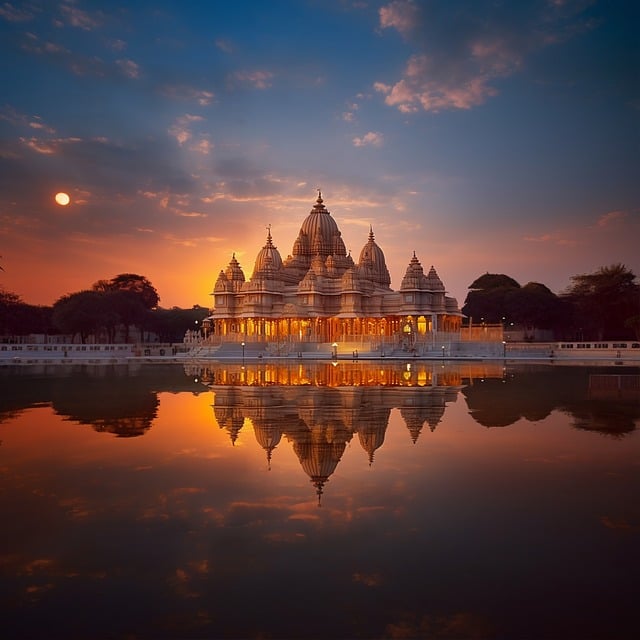Ayodhya Ram Mandir - A Symbol of Faith and Unity in Modern India

Strong 8k brings an ultra-HD IPTV experience to your living room and your pocket.
Just south of the city of Ayodhya in the northern state of Uttar Pradesh, India, stands the iconic Ram Mandir, a symbol deeply rooted in the country's history and culture. The temple holds immense significance for millions of Hindus worldwide, as it is believed to be the birthplace of Lord Ram, a revered deity in the Hindu religion.
Over the centuries, the Ayodhya Ram Mandir has been a focal point of both religious devotion and political strife. The recent construction of the grand temple in Ayodhya has been a monumental moment in Indian history, symbolizing faith, unity, and the coming together of a diverse nation under a shared cultural heritage.
Key Takeaways:
- Historical significance: The Ayodhya Ram Mandir holds immense historical and cultural significance as it is believed to be the birthplace of Lord Rama, a revered figure in Hinduism.
- Symbol of unity: The construction of the temple serves as a symbol of unity and harmony in modern India, bringing together people of different faiths and backgrounds to celebrate a shared cultural heritage.
- Resurgence of faith: The completion of the Ayodhya Ram Mandir reflects the resurgence of religious faith and devotion in contemporary Indian society, highlighting the continued importance of spirituality in shaping national identity.
Historical Context
Ancient References and The Ramayana
One of the oldest references to Ayodhya can be found in the ancient Hindu scriptures, the Ramayana. This epic tale narrates the life and adventures of Lord Rama, who is believed to be an incarnation of the god Vishnu. Ayodhya is depicted as the capital city of the legendary King Dasharatha, Rama's father. The Ramayana describes the glory and grandeur of Ayodhya, portraying it as a city of righteousness and prosperity.
One of the most famous episodes in the Ramayana is the exile of Rama to the forest and the subsequent construction of a bridge by his army of Vanaras (monkey-men) to rescue his wife Sita from the demon king Ravana in Lanka. These stories have ingrained Ayodhya in Hindu consciousness as a place of religious significance and historical importance.
The Political History of the Ayodhya Dispute
One of the most contentious issues surrounding Ayodhya in modern times is the Babri Masjid-Ram Janmabhoomi dispute. The dispute dates back to the 16th century when the Mughal Emperor Babur constructed a mosque at the site believed to be the birthplace of Lord Rama. The mosque was destroyed by Hindu activists in 1992, leading to communal riots and tensions that have persisted for decades. The dispute has been a focal point for Hindu-Muslim relations and has become a symbol of religious and political conflict in India.
To explore deeper into the political history of the Ayodhya dispute, it is necessary to understand the complex dynamics of religious and cultural identities in India. The Babri Masjid-Ram Janmabhoomi issue has been used by various political parties to mobilize support from different sections of society, leading to polarization and division among communities. The legal battles and negotiations surrounding the disputed site have been as tumultuous as the public sentiments it evokes.
The Architecture of Ayodhya Ram Mandir
Even before its construction, the Ayodhya Ram Mandir stood as a magnificent symbol of faith and unity in modern India. The architecture of the temple represents a blend of various styles and influences, making it a testimony to the rich cultural heritage of the country.
Design and Structural Elements
An architectural marvel, the Ayodhya Ram Mandir showcases intricate carvings, grand spires, and artistic domes that reflect the traditional Nagara style of temple architecture. The temple is built using ancient construction techniques and materials, ensuring its longevity and grandeur.
The structural elements of the Ayodhya Ram Mandir are a sight to behold, with each pillar, wall, and ceiling telling a story of devotion and craftsmanship. The temple's layout is meticulously planned, with a central sanctum dedicated to Lord Ram, surrounded by smaller shrines and prayer halls for devotees.
Symbolism Embedded in the Architecture
Embedded in every corner of the Ayodhya Ram Mandir are symbols and motifs that hold deep spiritual significance for devotees. The temple's architectural design is not merely ornamental but serves a higher purpose of conveying the divine presence of Lord Ram and the ideals he represents.
Symbolism plays a crucial role in the architecture of the Ayodhya Ram Mandir, with each element carrying layers of meaning that resonate with the beliefs and values of the Hindu community. From the placement of sculptures to the alignment of sacred symbols, every detail in the temple's design communicates a profound message of spirituality and devotion.
Architecture of the Ayodhya Ram Mandir stands as a timeless ode to the glory of Lord Ram and a testament to the unity and faith that binds millions of devotees across the nation.
The Legal Battle and Resolution
Many decades of legal battles and contentious disputes surrounded the Ayodhya Ram Mandir issue, with both Hindu and Muslim communities claiming ownership of the land. The legal battle over the site of the Babri Masjid and the subsequent construction of the Ram Mandir was one of the most complex and emotionally charged legal disputes in India's history.
Major Court Rulings and Judgments
Battle lines were drawn as various court cases and appeals were filed by both parties, leading to years of legal wrangling. The turning point came in 2010 when the Allahabad High Court ruled to divide the disputed land into three equal parts, with one-third going to each of the Hindu and Muslim litigants, and the remaining third allocated to the Nirmohi Akhara.
In a historic judgment on November 9, 2019, the Supreme Court of India unanimously ruled in favor of the construction of the Ram Mandir at the disputed site, while also directing the government to allocate a separate five-acre plot of land to the Sunni Waqf Board for the construction of a mosque. This landmark decision brought an end to decades of legal battles and paved the way for a resolution to the Ayodhya Ram Mandir dispute.
The Role of the Indian Judiciary in Resolving the Dispute
For years, the Indian judiciary played a crucial role in examining the legal nuances of the Ayodhya dispute and arriving at a fair and just decision. The Supreme Court's meticulous examination of historical evidence, legal arguments, and religious sentiments helped bring closure to a long-standing issue that had divided communities for generations.
Legal experts praised the judiciary's handling of the case, citing its transparent and impartial approach in interpreting the law and upholding the principles of justice and equality. The resolution of the Ayodhya Ram Mandir dispute through legal means stands as a testament to the efficacy of the Indian judicial system in resolving complex and deeply rooted conflicts.
The Construction Process
Steps Involved in Building the Mandir
Construction of the Ayodhya Ram Mandir involved several meticulously planned steps that were carried out with precision and dedication. The first step included clearing the site and preparing the foundation for the temple. This was followed by the construction of the base for the main structure, which laid the groundwork for the intricate design to come.
Next, skilled artisans and craftsmen meticulously carved and assembled the intricate pieces of stone that would form the walls, pillars, and domes of the temple. Each piece was intricately designed with traditional motifs and symbols significant to the Ramayana epic, adding to the grandeur and beauty of the structure.
Role of Technology and Traditional Craftsmanship
Construction of the Ayodhya Ram Mandir was a harmonious blend of modern technology and traditional craftsmanship. Advanced tools and machinery were used for tasks such as heavy lifting and precision cutting, ensuring efficiency and accuracy in the construction process.
However, the essence of the temple lies in its intricate carvings and detailed craftsmanship, which were predominantly done by skilled artisans using traditional tools and techniques passed down through generations. This fusion of technology and tradition not only accelerated the construction process but also ensured that the temple embodied the rich cultural heritage of India.
The integration of modern technology with traditional craftsmanship not only accelerated the construction process but also ensured the preservation of age-old techniques and artistry. The intricate carvings and designs on the temple walls stand as a testament to the dedication and skill of the craftsmen involved in building the magnificent Ayodhya Ram Mandir.
Ayodhya Ram Mandir as a Unifying Force
Impact on Hindu-Muslim Relations
For centuries, the Ayodhya Ram Mandir has been a contentious issue between Hindus and Muslims in India. However, the recent construction of the Ram Mandir has brought a sense of reconciliation and harmony between the two communities. The Supreme Court's verdict in 2019, which allowed for the construction of the Mandir while also providing alternate land for a mosque, paved the way for healing wounds and fostering mutual respect.
ForceThe shared reverence for Lord Ram as a revered figure in both Hinduism and Sufism has further bridged the gap between Hindus and Muslims. The construction of the Ram Mandir stands as a symbol of religious tolerance and coexistence, signifying that faith can be a unifying force rather than a source of division.
The Mandir as a Catalyst for Regional Development
ForceThe Ayodhya Ram Mandir has not only served as a spiritual center but also as a catalyst for regional development. The influx of pilgrims and tourists to the holy site has boosted the local economy, creating opportunities for businesses and employment in the region. The government's focus on infrastructural development in and around Ayodhya has further enhanced the overall growth and prosperity of the area.
MandirAnother aspect of the Mandir's impact on regional development is its role in promoting cultural tourism. The rich history and architectural significance of the Ram Mandir have attracted scholars, researchers, and tourists from across the globe, showcasing the cultural heritage of India and fostering a sense of pride among its citizens.
Challenges and Criticisms
Opposition and Controversy Surrounding the Mandir
All across India, the construction of the Ayodhya Ram Mandir has been a topic of heated debate and contention. While many hail the temple as a symbol of religious and cultural pride, there are voices of opposition that argue against its construction. Critics often point to the disputed history of the site and argue that the temple's construction could deepen religious divides in an already diverse society.
Furthermore, there are concerns about the implications of building a Hindu temple at a site with a history of religious conflict. Some fear that the construction of the mandir could set a precedent for other religious groups to assert their dominance over contested sites, potentially leading to further disputes and tensions.
Addressing Issues of Secularism and Pluralism
The Ayodhya Ram Mandir project faces challenges in upholding India's secular ideals and promoting religious pluralism. The government and project leaders have been called upon to ensure that the construction and promotion of the temple do not undermine the secular fabric of the country. It is vital for the authorities to navigate these delicate issues with sensitivity and inclusivity.
For instance, efforts to engage with and involve diverse religious communities in the construction and management of the mandir can help promote a message of unity and inclusivity. By welcoming input and participation from various religious groups, the project can strive to be a beacon of religious harmony and tolerance in modern India.
The Role of the Ayodhya Ram Mandir in Modern Indian Politics
How the Mandir Shapes National Identity and Patriotism
For centuries, the Ayodhya Ram Mandir has been at the heart of India's identity and patriotism. The belief in Lord Ram transcends regional, cultural, and linguistic boundaries, uniting the diverse tapestry of Indian society under one common faith. The construction of the Ram Mandir stands as a symbol of pride and devotion for millions of Indians, reinforcing their sense of national identity and patriotism.
The Mandir's significance goes beyond religion; it represents the triumph of good over evil and serves as a reminder of India's rich cultural heritage and history. As a sacred site that embodies the ideals of righteousness and justice, the Ayodhya Ram Mandir inspires Indians to uphold these values in their daily lives, fostering a spirit of unity and patriotism among the citizens of modern India.
The Mandir's Influence on Political Dialogue and Elections
Patriotism
Indian politics has been deeply impacted by the Ayodhya Ram Mandir issue, with political parties using it as a tool to mobilize voters and shape public discourse. The Ram Mandir has become a key electoral issue, with parties vying to showcase their commitment to the construction of the temple in order to garner support from the devout followers of Lord Ram. This has led to the Mandir playing a pivotal role in shaping political dialogue and influencing electoral outcomes in modern India.
Pilgrimage and Tourism
The Mandir as a Pilgrimage Destination
For centuries, Ayodhya has been revered as the birthplace of Lord Ram, making it a significant pilgrimage site for millions of devotees from across India and around the world. The construction of the Ram Mandir further solidifies Ayodhya's importance as a sacred destination for Hindus. Pilgrims visit the Mandir to pay their respects to Lord Ram and seek blessings for themselves and their families.
The architecture and grandeur of the Ram Mandir, along with the spiritual significance attached to it, draw devotees in large numbers. The serene atmosphere and the aura of devotion make it a place of solace and reflection for visitors, who often spend hours in prayer and meditation within the premises of the Mandir.
Economic and Social Effects of Tourism
On the economic front, the influx of pilgrims and tourists to Ayodhya due to the presence of the Ram Mandir has led to a boost in the local economy. The increased demand for accommodation, food, and souvenirs has created employment opportunities for the local population. Small businesses and vendors in the vicinity of the Mandir have flourished due to the steady stream of visitors.
Furthermore, tourism has helped in fostering social cohesion and harmony among people of diverse backgrounds. The shared experience of visiting a sacred site like the Ram Mandir has the power to transcend differences and bring individuals together in a spirit of unity and brotherhood.
Tourism not only contributes to the economic growth of the region but also plays a pivotal role in promoting cultural exchange and understanding among people. It serves as a bridge that connects individuals from various walks of life and reinforces the idea of unity in diversity.
Ayodhya Ram Mandir in the Arts and Media
Depictions in Literature, Film, and Television
The Ayodhya Ram Mandir has been a recurring theme in various forms of artistic expression in India. Literature, film, and television have all portrayed the significance of the temple in different ways. From ancient texts like the Ramayana to modern-day cinematic interpretations, the story of Lord Ram and the sacredness of the Ayodhya Ram Mandir continue to inspire artists and filmmakers.
Depictions of the Ayodhya Ram Mandir in films and television series have not only served as entertainment but also as a means to educate the masses about the rich cultural and religious history associated with the temple. These artistic representations have played a role in connecting people from diverse backgrounds to the story of Lord Ram and the importance of the Ayodhya Ram Mandir in Indian society.
Role in Promotion of Arts and Craft in the Region
Promotion of arts and crafts in the region surrounding the Ayodhya Ram Mandir has been integral to preserving traditional craftsmanship and showcasing the cultural heritage of the area. The temple has been a patron of local artisans, supporting their work and providing a platform for showcasing their talent to a larger audience.
The Ayodhya Ram Mandir's promotion of arts and crafts has not only provided economic opportunities for local artisans but has also helped in keeping traditional art forms alive. The intricate carvings, paintings, and sculptures found within the temple complex are a testament to the rich artistic legacy that the region has to offer.
More about the Role in Promotion of Arts and Craft in the Region
Mandir's support for arts and crafts has led to the establishment of training programs and workshops to pass on traditional skills to the next generation. This has not only ensured the continuity of these art forms but has also helped in creating a sustainable model for preserving cultural heritage through art and craft.
Looking Ahead: The Future of Ayodhya Ram Mandir
Now that the Ayodhya Ram Mandir stands as a symbol of faith and unity in modern India, it is crucial to consider the long-term visions and plans for this sacred site. Any discussion on the future of the Ayodhya Ram Mandir must prioritize its preservation, maintenance, and continuous spiritual significance. The architectural grandeur and historical importance of the temple demand careful attention to ensure its longevity for generations to come.
Long-Term Visions and Plans
Any development plans for the Ayodhya Ram Mandir should focus on enhancing the visitor experience, promoting cultural understanding, and fostering spiritual growth. Preserving the sanctity of the site while accommodating the needs of pilgrims and tourists will be crucial in maintaining the Mandir's integrity and relevance. Additionally, efforts to expand educational programs, promote sustainable practices, and engage with the local community will be crucial for the holistic development of the Ayodhya Ram Mandir.
The Mandir's Role in Global Hinduism
To understand the significance of the Ayodhya Ram Mandir in the global context of Hinduism, one must appreciate its role as a beacon of religious and cultural identity. The temple serves as a symbol of unity, faith, and resilience for Hindus worldwide, showcasing the enduring spirit of devotion and reverence that transcends geographical boundaries. The completion of the Ayodhya Ram Mandir has not only solidified its place in India's religious landscape but has also reinforced its connection to Hindu communities around the world.
Mandirs like the Ayodhya Ram Mandir play a vital role in preserving and promoting Hindu heritage, traditions, and values on a global scale. As centers of spiritual practice, cultural celebration, and community engagement, these sacred spaces serve as anchors for the Hindu diaspora and as sources of inspiration for all seekers of truth and wisdom.
Final Words
With this in mind, the historic settlement of the Ayodhya Ram Mandir issue and the subsequent construction of the temple stands as a symbol of faith and unity in modern India. The resolution of this long-standing dispute not only signifies the importance of acknowledging and respecting diverse religious beliefs but also underscores the potential for peaceful coexistence and harmony among different communities.
The Ayodhya Ram Mandir represents a significant milestone in India's journey towards communal harmony and serves as a powerful reminder of the country's rich cultural heritage and pluralistic ethos. As the temple stands as a testament to the shared history and beliefs of millions of Indians, it stands as a beacon of hope and unity in a diverse and multicultural society, showcasing the power of faith to bring people together despite their differences.
FAQ
Q: What is the significance of Ayodhya Ram Mandir in modern India?
A: The Ayodhya Ram Mandir holds immense significance as a symbol of faith and unity in modern India. It represents the cultural and historical heritage of the country and serves as a unifying force for people of different backgrounds.
Q: Why is the construction of the Ayodhya Ram Mandir considered a historic event?
A: The construction of the Ayodhya Ram Mandir is considered a historic event due to the long-standing dispute surrounding the site, which dates back several decades. The resolution of this dispute and the construction of the temple is seen as a significant milestone for religious harmony and unity in India.
Q: How does the Ayodhya Ram Mandir promote unity among the people of India?
A: The Ayodhya Ram Mandir promotes unity among the people of India by bringing together individuals from various communities and beliefs to worship and celebrate a shared cultural and religious heritage. The temple serves as a symbol of harmony and peace, fostering a sense of togetherness and mutual respect among all citizens.
Note: IndiBlogHub features both user-submitted and editorial content. We do not verify third-party contributions. Read our Disclaimer and Privacy Policyfor details.








